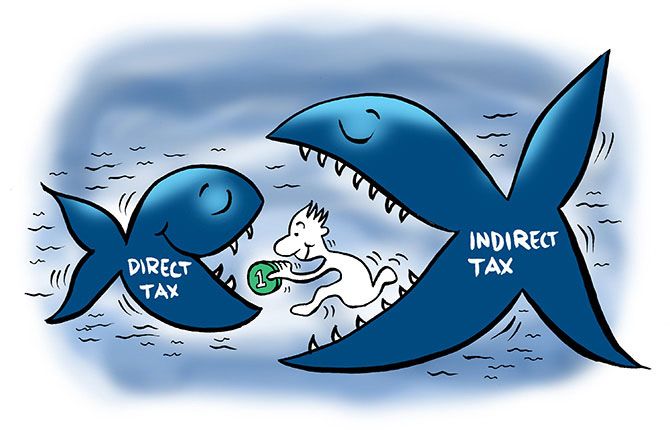
The finance minister, while presenting his annual Budget speech, ended on a positive note with a declaration that the government will incur a revenue gain of Rs 19,600 crore in the Union Budget 2016 proposals. Decoding the revenue gain numbers, the Budget proposals listed offer the government a revenue loss of Rs 1,060 crore through direct tax proposals and a Rs 20,670 crore revenue gain through various indirect tax proposals.
Here is a microscopic view of all tax-related proposals and an in-depth analysis of how taxation aspects pan out for the common man and the corporate world.
Direct Taxes
Relief for small taxpayers under Section 87A: The Budget 2016-17 has placed emphasis on the rural population, on those living under poverty line, and the small taxpayeRs For those having an income of up to Rs 5 lakh, there is good news, as the maximum ceiling under Section 87A has been increased from Rs 2000 to Rs 5000. Translated, it means an additional tax advantage of Rs 3000 for those who fall in the 10 per cent tax bracket.
15 per cent Surcharge for the ultra-rich: It is often expected of the rich to pay more tax than the poor and the middle class, which constitute the majority of Indian taxpayeRs As a small but significant step in this direction, the Finance Minister has introduced a 15 per cent surcharge that will be levied on income tax for those individuals having an annual income of more than Rs 1 crore.
Increase in HRA deductions: With rental prices rising pan India in recent times, the Rs 24,000 tax deduction under Section 88G had proved insufficient in providing any substantial tax benefits. The Finance Minister has increased the tax rebate on housing rent to Rs 60,000 per annum. Consequently, if you are in the 10 per cent tax bracket, you can avail an additional tax savings of Rs 3,600. The increase in tax deduction takes into account the rising rental prices across India in both urban and semi urban centers, which will bring some relief towards the salaried class who are staying on rent and do not own a house.
NPS withdrawal taxation exemptions: The vastmajority of India still does not have sufficient pension investments. The government’s move to make NPS a popular pension instrument during the previous Budget had not been lapped up by the masses as was expected, as it came tagged with taxation on corpus available upon withdrawal.
The Finance Minister has made an announcement in this Budget to make the NPS corpus available for withdrawal tax-free up to 40 per cent of the total corpus. Hence, an investor having a Rs 10 Lakh corpus in NPS will realize a tax savings of Rs 40,000 upon withdrawal, as compared to status quo currently.
Additional tax relief for first-time home buyers: If you are a first-time home buyer looking to buy a residential property under Rs 50 lakh by availing a loan of less than 35 lakh, you will get an additional tax exemption of Rs 50,000 on interest repayment. These exemptions are over and above the Rs 2 lakh benefit for interest repayment under Section 24 and Rs 1.5 lakh for repayment of principle amount under Section 80C.
Reduction in LTCG timeline: Another major tax incentive in the Budget has been the announcement to reduce the period of long term capital gains tax for shares of unlisted companies. The timeline has been reduced from the current level of 3 years to 2 yeaRs The move is likely to help investors like private equity funds and other retail investors looking at exit options from their investments in such companies.
Dividend taxation: A dividend tax has been announced for high net worth investors, which will be applied at 10 per cent for persons and HUFs receiving dividend more than Rs 10 lakh. This dividend tax is in addition to the 28.84 per cent that the company already pays on its generated income.
Indirect Taxes
- Introduction of Krishi Kalyan Cess: If Swach Bharat was the talk of the town in the previous Budget, now it is the turn of the Krishi Kalyan cess. The finance ministry has introduced a Krishi Kalyan cess to the tune of 0.5 per cent, which will be applied on all taxable services. This increases service tax from its current rate of 14.5 per cent to 15 per cent. This is prone to denting the common man’s pocket while paying for services, hotel bills, insurance premiums, telephone bills, and every allied utility services.
Corporate Taxes
- More SMEs under presumptive taxation method: The one big tax-related hassle for SMEs was to keep its statement of accounts and audited reports updated. To ensure ease of doing business, the finance ministry has allowed all SMEs with a turnover of up to Rs 2 crore to use presumptive income method for tax calculation. This is an increase from the Rs 1 crore turnover limit as applicable earlier. Now, all SMEs with turnover up to Rs 2 crore can pay tax at 8 per cent profit assumptions under Section 44AD.
- Lower corporate tax for small businesses: Other small business entities have also found favor from the Finance Minister as the corporate income tax rate for the financial year 2017 for all relatively small enterprises with a turnover of less than Rs 5 crore is now limited to 29 per cent plus cess.
With a focus on direct, indirect, and corporate tax structures, the Budget 2016-17 offers a balanced taxation structure with adequate measures for both corporate world and the common man.
Illustration: Uttam Ghosh/Rediff.com
BankBazaar.com is a marketplace where you can compare and apply online for loans to meet all your personal loan, home loan, car loan and credit card needs from India's leading banks and NBFCs.











